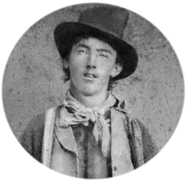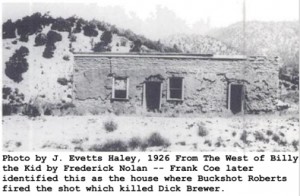 This gun battle at Blazer’s Mill, located on the Rio Tularosa, is considered part of the Lincoln County War of 1878. The most famous participant of that war was, of course, William H. Bonney, a.k.a. “Billy the Kid.” Billy and his fellow posse members called themselves the “Regulators” and were led by Dick Brewer. Their “opponents” were the Murphy-Dolan faction who aligned themselves with Lincoln County Sheriff William Brady.
This gun battle at Blazer’s Mill, located on the Rio Tularosa, is considered part of the Lincoln County War of 1878. The most famous participant of that war was, of course, William H. Bonney, a.k.a. “Billy the Kid.” Billy and his fellow posse members called themselves the “Regulators” and were led by Dick Brewer. Their “opponents” were the Murphy-Dolan faction who aligned themselves with Lincoln County Sheriff William Brady.
The Regulators were more or less the “extra-legal” force for the Tunstall-McSween faction who supported the town constable Dick Brewer (the Regulators’ leader). Tensions between the two factions had been brewing for awhile but erupted into a full-scale county war early in 1878. On February 18, John Tunstall was murdered, which precipitated the organization of Brewer’s posse.
Sheriff Brady was later killed on April 1. These two events set the stage for the gun battle at Blazer’s Mill. Andrew L. “Buckshot” Roberts would be drawn into the war whether he wanted it or not because the Regulators thought he might have been involved in Tunstall’s murder.
 The history of Andrew Roberts is, at best, sketchy. Many stories and theories abound as to his origins. Some believe he was from Texas, others believe he was born farther east. His grave stone has a marker indicating he fought as a Confederate in the Civil War. Another theory has him joining the Texas Rangers after the war and fighting Indians – yet another story has him later doing battle against the Texas Rangers. Some historians suggest that he was once a buffalo hunter and rode with William F. “Buffalo Bill” Cody.
The history of Andrew Roberts is, at best, sketchy. Many stories and theories abound as to his origins. Some believe he was from Texas, others believe he was born farther east. His grave stone has a marker indicating he fought as a Confederate in the Civil War. Another theory has him joining the Texas Rangers after the war and fighting Indians – yet another story has him later doing battle against the Texas Rangers. Some historians suggest that he was once a buffalo hunter and rode with William F. “Buffalo Bill” Cody.
Whatever his true history, along the way he earned the moniker of “Buckshot” after he was shot up so bad his right arm was crippled. After that he wasn’t able to lift a rifle to his shoulder – he shot strictly from the hip. At some point, perhaps wanting to settle down with a more peaceful existence, he bought a little ranch near Ruidoso. While he officially took no sides in the Lincoln County Wars, it was generally believed that he aligned himself with the Dolan-Murphy faction.
Noted author and western historian Emerson Hough wrote about Roberts in his book The Story of the Outlaw: A Study of the Western Desperado:
When the Lincoln County War broke out, he was recognized as a friend of Major Murphy, one of the local faction leaders; but when the fighting men curtly told him it was about time for him to choose his side, he as curtly replied that he intended to take neither side; that he had seen fighting enough in his time, and would fight no man’s battle for him. This for the time and place was treason, and punishable with death. Roberts’ friends told him that Billy the Kid and Dick Brewer intended to kill him, and advised him to leave the country.
Roberts decided to do just that as he sold his property and prepared to leave. Again there are various theories as to why Roberts rode into Blazer’s Mill on April 4 (just three days after Sheriff Brady had been murdered). Hough mentions three theories or rumors: that he went to meet a friend who had been badly wounded; he went to confront Major Godfroy who he’d had a disagreement with; or he was headed there to kill none other than Billy the Kid. Hough thought it more likely he was there to visit his friend.
Yet another story, which might be the most plausible of all, was that he was there checking to see if payment for his land sale had arrived in the mail. Again, whatever the actual facts, it appears he unknowingly rode in to find the Regulators were also there. One member of the Regulators, Frank Coe, asked Roberts to give up his weapons, which Roberts refused to do. Meanwhile the rest of the Regulators had retreated behind a house.
One eyewitness said that suddenly the rest of the gang came from behind the house and began firing at Roberts. Rather than retreat inside the house, Roberts began firing on the Regulators (twelve or thirteen men). Roberts shot Jack Middleton (although not mortally wounded), shot off George Coe’s finger, grazed another one or two and almost got off a shot at Billy the Kid, but instead his gun misfired.
Charlie Bowdre came around the house next and Roberts fired at him, striking his belt and cutting it off. Bowdre almost simultaneously fired at Roberts and wounded him – although later other Regulators would claim they actually shot Roberts. Roberts now retreated back into the house. Having run out of ammunition for his own rifle, he picked up another rifle and pulled a mattress to the floor and laid upon it near the open window at the front of the house.
By this time, everyone had retreated, but Dick Brewer decided to take matters into his own hands. He approached the house by crossing the river over a foot bridge. When he found a strategic spot from which to take aim (about 125 yards west of the house), he fired into the house. While his shot did nothing but scatter bits of adobe, it gave Roberts a bead on where his target was hiding.
Even though Brewer’s eyes were barely visible above the pile of logs where he was hiding, Roberts, himself severely wounded, fired and struck Dick Brewer in the eye – blowing off the top of his head. With Brewer laying dead, Billy the Kid became the de facto leader and ordered his men to retreat. It was apparent to them that their scrappy opponent would kill them all if he had the chance. Billy the Kid would remember the gun battle by remarking, “Yes sir, he licked our crowd to a finish.”
Buckshot Roberts did indeed hold his own against the Regulators, but on April 5 he died after attempts to save his life failed. Before he died he was so desperately in pain that two men had to hold him down. Eyewitness Johnny Patten claimed that he built a coffin in the shape of a big “V” so that both Roberts and Brewer could be buried side by side. “We just put them both in together,” said Patten, “and there they lie today grim grave-company.”
When Emerson Hough visited the battle site in 1905 he verified and measured the distances reported. It was indeed a 125-yard downhill shot made by Roberts which killed Dick Brewer. For someone with such great odds against him, not to mention his inability to lift a rifle to shoulder-level, Buckshot Roberts put up one heck of a fight. According to one source, it was later proven that he had nothing to do with Tunstall’s murder.
 Did you enjoy this article? Yes? Check out Digging History Magazine. Since January 2018 new articles are published in a digital magazine (PDF) available by individual issue purchase or subscription (with three options). Most issues run between 70-85 pages, filled with articles of interest to history-lovers and genealogists — it’s all history, right? 🙂 No ads — just carefully-researched, well-written stories, complete with footnotes and sources.
Did you enjoy this article? Yes? Check out Digging History Magazine. Since January 2018 new articles are published in a digital magazine (PDF) available by individual issue purchase or subscription (with three options). Most issues run between 70-85 pages, filled with articles of interest to history-lovers and genealogists — it’s all history, right? 🙂 No ads — just carefully-researched, well-written stories, complete with footnotes and sources.
Want to know more or try out a free issue? You can download either (or both) of the January-February 2019 and March-April 2019 issues here: https://digging-history.com/free-samples/
Thanks for stopping by!


Well in the movie young guns he wAs the aggressor and came off AZ a big asshole